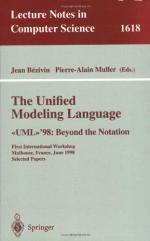|
This section contains 417 words (approx. 2 pages at 300 words per page) |

|
The Unified Modeling Language (UML) is a graphical language used to visualize, specify, construct, and document an object-oriented or component-based software system. It is a notation for expressing analysis and design that supports many programming languages but is independent of programming language itself.
Before the UML, a number of similar analysis and design methods with slight differences were used for object-oriented development, including the Booch method, Object Modeling Technique (OMT), the Rational Unified Process (RUP), and Object-Oriented Software Engineering (OOSE). Each of these methods was evolving along its own path, and no clear leader had emerged. In the 1990s Rational Software Corporation and leading methodologists Grady Booch, James Rumbaugh, and Ivar Jacobson began an effort to fuse the best practices of existing methods into a single modeling language. The UML is a successor to these earlier methods.
The foundation of the UML...
|
This section contains 417 words (approx. 2 pages at 300 words per page) |

|


